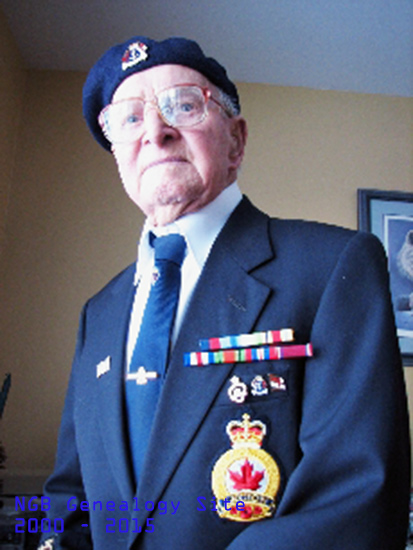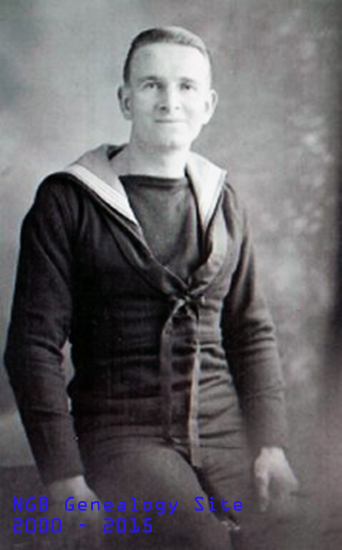Presented by the
Newfoundland's Grand Banks Site
to assist you in researching your Family History
Click on the graphic below to return to the NGB Home Page
To contribute to this site, see above menu item "About".
These transcriptions may contain human errors.
As always, confirm these, as you would any other source material.
Photo by
Barbara Dean-Simmons
of The Packet

William J.H. Mills
P/SSX31752 Royal Navy
1939 – 1946
Barbara Dean-Simmons
of The Packet

William J.H. Mills
P/SSX31752 Royal Navy
1939 – 1946
| Shoal Harbour man to receive France’s highest military honour
Contributed by Branch 27 The Packet William Mills of Shoal Harbour will be presented with France’s highest military honour, the Legion of Honour, later this year. It’s an honour the French government is bestowing on Allied veterans who participated in the Invasion of Normandy on D-Day, June 6, 1944.  Mills joined the Royal Navy in St. John’s in August, 1939.
Mills joined the Royal Navy in St. John’s in August, 1939.After a stint on the Dundee, which was torpedoed on Sept. 15, 1940, he was drafted into the Royal Navy Commandos, later known as the Combined Operations Branch. From December, 1940, until the end of 1943, he spent most of his time in the Middle East, participating in the Battle for Crete, the Tobruk Supply Run, and did service in Ceylon (now Sri Lanka), the Maldives, and India. In January, 1944, he was assigned to the Landing Craft Assault Flotilla on H.M.S. Princess Astrid, a converted Belgian steamer, and part of the Five-Hundreth Assault Flotilla. The Princess Astrid carried eight LCA (Landing Craft Assault) and 250 troops. Mills was coxswain of LCA360, or P3, the third LCA on the port side. Several months of intense training followed, and at 0900 hours on Friday, June 2, 1944, when the No. 4 Commandos boarded the Princess Astrid in Southampton, the ship’s crew knew something big was about to happen. Preparing for June 6 On Sunday, June 4, the crew was told of their mission — the impending landing of troops at Normandy; “D” Day. At 2100 hours (9 PM) on Monday the large flotilla of vessels left the coast of England to be in position for the landings which were to begin at dawn the next day. Princess Astrid was one of six ships in Force “J”. At 0200 hours on Tuesday morning they entered the channels which had been earlier cleared of mines by a fleet of 70 Allied minesweepers. The crews of manned their landing craft and remained there until 0500 when they went for breakfast. At 0530 they returned to their craft and were lowered to the landing ramps, where the commandos boarded for the last time. Each landing craft carried 32 Commandos. At 0610 they were lowered to the sea. As this was taking place, there was a huge explosion off their port beam. The Norwegian destroyer “Stord”, one of the destroyer escorts, had strayed 10 yards outside the swept channel and touched a mine. The sight of this ship quickly sinking had a sobering effect on all who witnessed it, reminding them of the danger they all faced. After rendezvousing with all other LCI (Landing Craft, Infantry), the flotilla headed for the beaches of France. Mills’ destination was Red Beach in “A” sector, the little village of Ouistreham, the extreme left flank of the Allied beach-head. All landing craft were to arrive at the various beaches at 0700 hours, by which time it was hoped that the constant bombing would have rendered the beaches defenseless by the Germans. Each coxswain was to use his own judgment and initiative in beaching as well as leaving the beach. As Coxswain Mills later wrote, “Our job . . . was comparatively simple; we had to land our commandos in the right place at the right time. Whether we brought our boats back, or ourselves back, was of little importance, but we had to get our troops ashore.” The bombardment of the beach defenses had begun much earlier and the noise of bombings from aircraft and ships behind the landing craft was deafening. The four-man crew of the landing craft and the Commandos were in good spirits heading for their beach; mainly because they thought no German soldiers could survive the rain of bombs hailing down on them. It wasn’t long before the beach became visible and Coxswain Mills could see landing craft and tanks which had been smashed. It was also obvious the beach was still under the control of German troops,; they would have to force their way in. They soon came under fire from 80mm and 105mm weapons and mortar shells. No one had to be reminded to keep his head down! The words which had been uttered by the Captain “Your Commandos must be landed at all costs!” kept echoing through Mills’ mind and he was determined to get the job done. Now close enough to come under machine gun fire, engines at full throttle, they approached the obstacles which were the outer defenses. These were constructed of heavy timber forming tripods, with “teller” mines perched on the top. One touch of these mines could have been the end of the craft and its cargo. LCA360 was maneuvered around these and soon Coxswain Mills felt something strike the bottom of the landing craft. It was the inner defense, meaning the craft could proceed no further. The order was given to “down ramp”. The Commandos entered the water up to their knees and made for shore, with mortar shells bursting on the beach. Most didn’t make it. They were cut down by enemy fire, falling onto their face on the beach or in the water, becoming one of the casualties of this offensive. The beach was full of dead soldiers floating in and out with the breaking waves. The get-away LCA360 was the last to leave the beach, and as Mills gave the order “Full Astern” his craft was driven into a wrecked Landing Craft Tank (LCT) by the heavy waves. He managed to clear the LC from this obstacle only to wash into another, far more dangerous obstacle; the port side of the LCA was rubbing against one of the outer defense tripods. His heart in his mouth, Coxswain Mills watched the mine as the craft scraped ever so slowly by it, all the while under artillery and mortar fire from the beaches. Now under “full throttle” they headed out to sea with a German gun still lobbing shells at them. They were soon out of range of the guns and headed back to the flotilla, but not without another problem. Mills realized that his craft was taking on water almost as fast as his men could pump it out. At about the same time they noticed another landing craft, LCA 494, appeared to be in some difficulty and had stopped. Coxswain Mills turned his craft around. LCA 494 was full of water and in danger of sinking but the crew declined help. However, as Mills and his crew watched, 494 drove her bow into a heavy wave and swamped! Mills could see three men in the water and one on the stern of the craft. Even though his own craft was in danger of swamping, Mills turned it around and picked up the men from 494. One of them was underwater when rescued by Mills and his Signalman, Simpson, and artificial respiration was used to bring him around. The rescue complete, Mills abandoned his attempt to make it to the Princess Astrid and headed for a closer ship, HMS Largo. However, just they had almost reached that ship, the Largo steamed away leaving them alone again. The water in the craft was now too much to handle and they were in imminent danger of sinking. The engines were stopped and all hands started bailing, using whatever was available, including tin helmets. The tide was pushing them back towards the beaches of Normandy. Yet luck was with them again that day as an LCM (Landing Craft Mechanical) came close enough to hail. As it came alongside, they abandoned ship and transferred to that vessel for transport to the Princess Astrid. William Mills left the Royal Navy in 1946 with the rank of Petty Officer. He settled in England, which remained his home until 2001. He moved back to Shoal Harbour that year where he now lives with his niece and family. It is for his participation in the landing of troops on “D” Day that Petty Officer Mills has been awarded the Legion of Honor by the Government of France. |
Return to the Main Military Records Index
Military Records Contact: Sherwin Flight
Newfoundland's Grand Banks is a non-profit endeavor.
No part of this project may be reproduced in any form
for any purpose other than personal use.
JavaScript DHTML Menu Powered by Milonic
© Newfoundland's Grand Banks (1999-2025)
Hosted by
![]()
Your Community, Online!
![[Recent]](../../recent.gif)
![[Home]](../../home.gif)